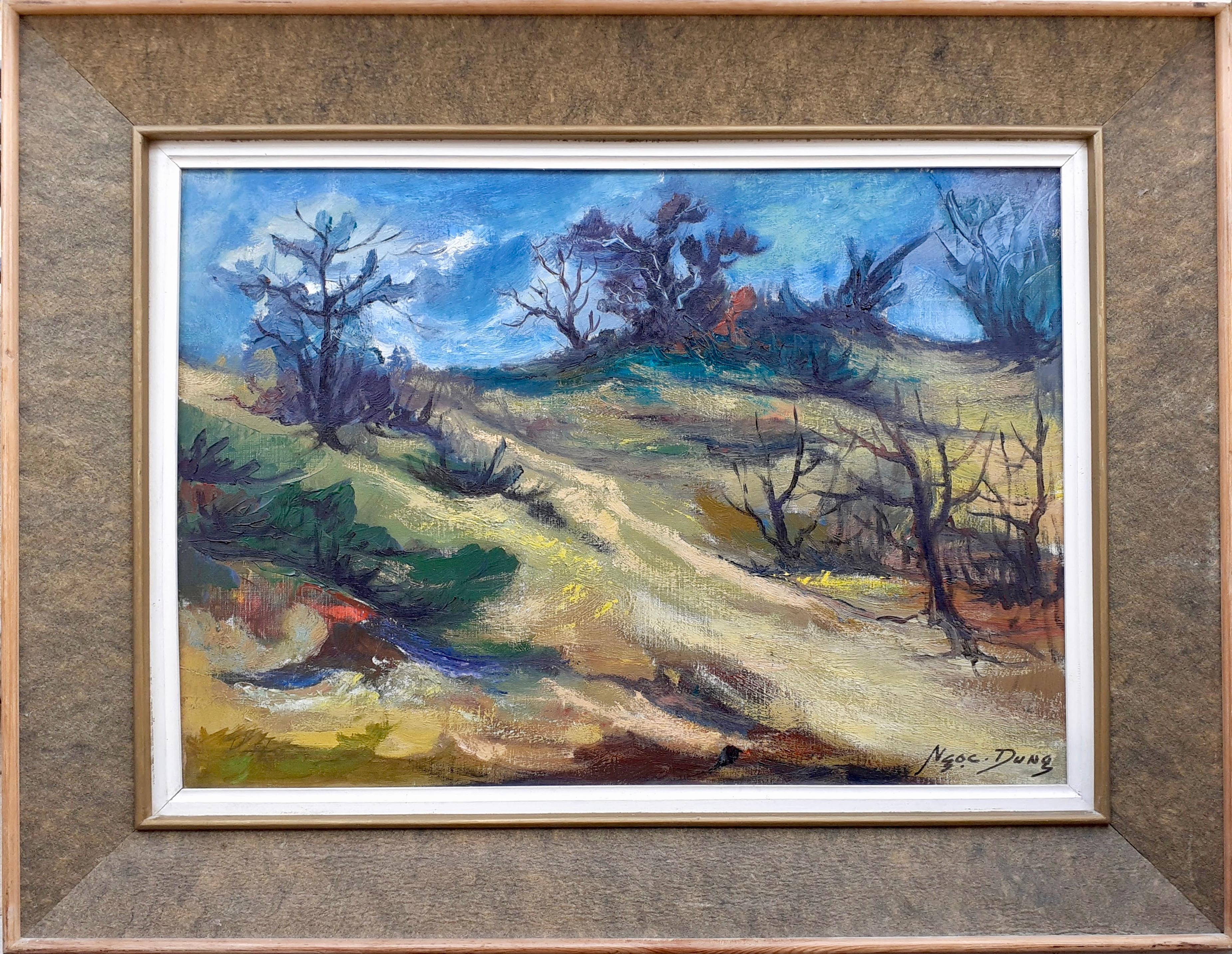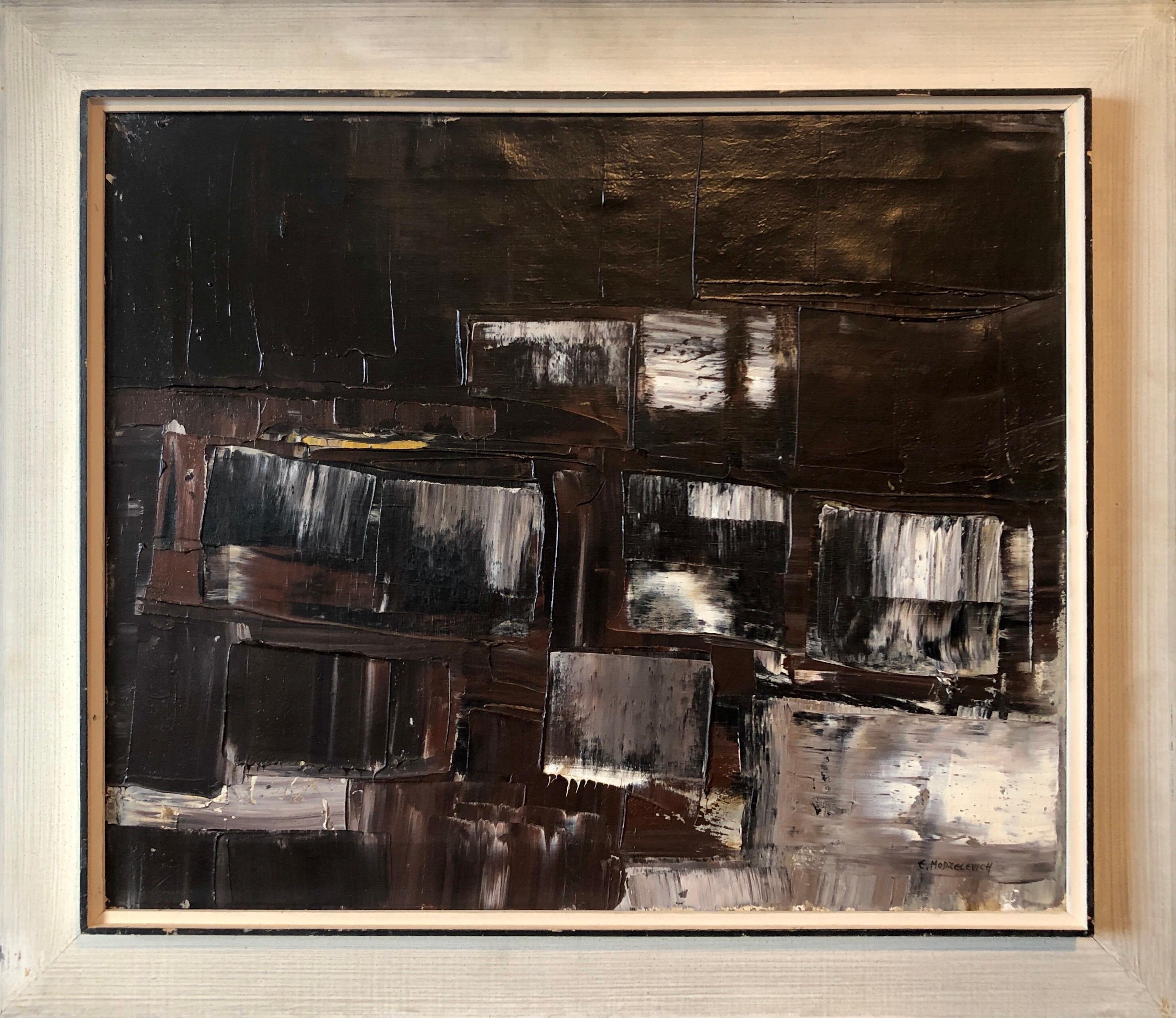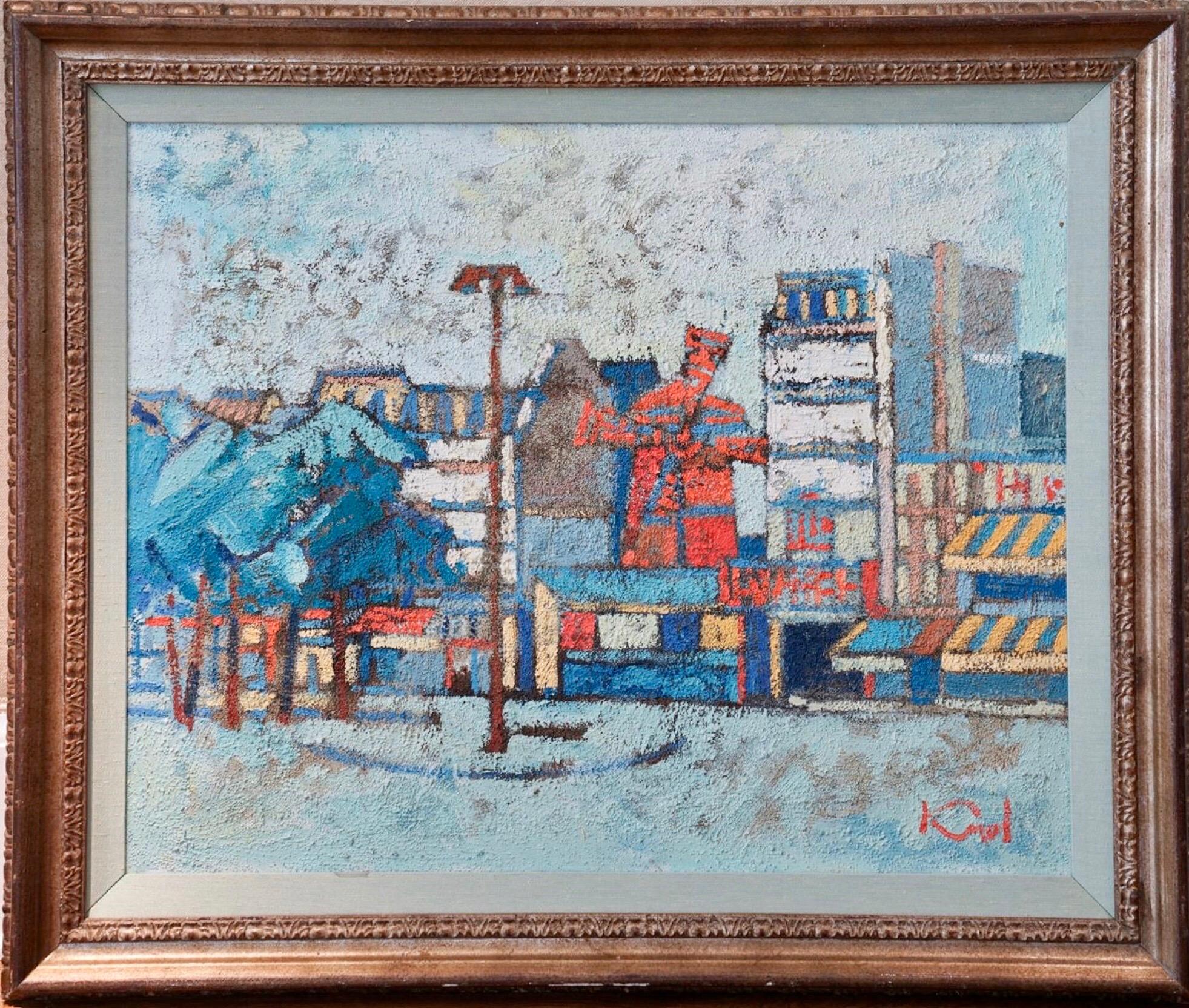Items Similar to "Sunset with Palm Trees" Modern Blue Toned Pointillist Tropical Landscape
Want more images or videos?
Request additional images or videos from the seller
1 of 15
Clark V. Fox"Sunset with Palm Trees" Modern Blue Toned Pointillist Tropical Landscape1980
1980
About the Item
Modern blue toned tropical landscape painting by Texas born artist Clark Fox. The work features an abstract depiction of a sunset behind palm trees using pointillism, the practice of applying small strokes or dots of color to a surface so that from a distance they visually blend together. Signed and dated in the front lower left corner. Currently hung in a light wood floating frame.
Dimensions Without Frame: H 24 in. x W 30 in.
Artist Biography: Clark V. Fox was born in Austin, TX, in 1946. His father in the Army Air Forces, Clark spent the first five years of his life in Honolulu before the family moved to several cities throughout Texas, including Galveston, Houston, Corpus Christi, Hereford and Amarillo. In 1960 just before Clark entered high school, the family settled in Washington, D.C. Clark attended high school in Alexandria, Virginia, a period during which he had a studio with fellow classmates, David Lynch and Jack Fisk. Clark studied with Japanese art master Unichi Hiratsuka at the Japan-American Society of Washington, D.C. (1964-1965). Clark spent his first year of college at Pratt Institute in Brooklyn, New York (1965-66) with part-time stints at Andy Warhol’s “The Factory” studio, after which he returned to D.C., where he received his BFA in 1969 from the Corcoran School of Art. He soon became involved with the Washington Color School of Painting, where he apprenticed with artist Tom Downing (1967-1969) and which brought him to the attention of James Harithas, then Director of the Corcoran Gallery of Art in D.C. Clark received a more hands-on introduction to the art world by accompanying Harithas to parties, exhibition openings and studio visits. Harithas would often see him in museums, studying and sketching various works in the many collections throughout D.C. In the 1970s, while protesting the second Indochina war, Clark found himself living between Paris and New York City.
It was then that he would become involved in the Situationist International and Fluxus Mail art school through Ray Johnson, while studying the works of Georges Seurat and Marcel Duchamp. In the 1980s Clark got involved in the D.C. Hardcore scene (his band, Twisted Teenage Plot, once opened for Fugazi at The White House) and the New York City No Wave movement with the noise-rock band Gag Reflex. He would later open MOCA, D.C., an art gallery in the Georgetown neighborhood of D.C., that exhibited the works of Shepard Fairey, Ron English and Mark Lombardi, among others. Clark also ran a conceptual art space Flat, out of his New York City apartment hosting experimental works of art. Harithas and Clark maintained close contact through it all. Clark’s work is in over fifty of the most prominent institutional collections in the United States, including Yale University Museum, Metropolitan Museum of Art, Brooklyn Museum, Whitney Museum, National Gallery of Art, Smithsonian American Art Museum, American University Museum, Rhode Island School of Design, The Phillips Collection and the High Museum. His work is in numerous notable private collections, including the Herbert and Dorothy Vogel Collection and the Richard Brown Baker Collection. Clark’s grants and awards include a Ford Foundation Grant (1965), First Purchase Award at the National Drawing Society Eastern Regional Exhibition, Philadelphia Museum of Art (1970), and Purchase Award, 35th Corcoran Biennial (1977).
- Creator:Clark V. Fox (1946, American)
- Creation Year:1980
- Dimensions:Height: 25.25 in (64.14 cm)Width: 31.25 in (79.38 cm)Depth: 1.63 in (4.15 cm)
- Medium:
- Movement & Style:
- Period:
- Condition:
- Gallery Location:Houston, TX
- Reference Number:

About the Seller
5.0
Vetted Seller
These experienced sellers undergo a comprehensive evaluation by our team of in-house experts.
Established in 1969
1stDibs seller since 2014
783 sales on 1stDibs
Typical response time: 9 hours
- ShippingRetrieving quote...Ships From: Houston, TX
- Return PolicyA return for this item may be initiated within 7 days of delivery.
More From This SellerView All
- "Classical Windows" Modern Grey and Black Toned Architectural Façade PaintingLocated in Houston, TXModern grey and black toned landscape painting by Texas born artist Clark Fox. The work features a clean-lined, geometric rendering of an architectural façad...Category
1970s Modern Landscape Paintings
MaterialsOil, Canvas
- Modern Abstract Cubist Inspired Landscape Painting of an Oceanside Boat DockLocated in Houston, TXModern abstract landscape painting by Houston, TX artist Margaret Nobler. The work features a boat floating near an oceanside dock with the sun setting...Category
1970s Modern Landscape Paintings
MaterialsCanvas, Oil
- “The Night” Blue, Black, & Brown Modern Abstract Surrealist Night LandscapeBy Robert GordyLocated in Houston, TXModern abstract landscape painting by Louisiana artist Robert Gordy. The work features his iconic tubular figure set against a surrealist night landscape scene. Signed and dated in t...Category
1960s Modern Abstract Paintings
MaterialsCanvas, Acrylic
- "Aspen Series 20" Green & Blue Abstract Impressionist Forest Landscape PaintingBy Earl StaleyLocated in Houston, TXGreen and blue toned landscape painting by Houston, TX artist Earl Staley. This painting depicts a lush, dense forest with a grove of trees in the center. Signed by artist in front c...Category
2010s Modern Landscape Paintings
MaterialsCanvas, Acrylic
- "Project Windows" Modern Pastel Pink and Yellow Toned Architectural PaintingLocated in Houston, TXModern pastel pink and yellow toned landscape painting by Texas born artist Clark Fox. The work features a clean-lined, geometric rendering of an architectur...Category
1970s Modern Landscape Paintings
MaterialsLinen, Oil
- Pastel-Toned Abstract Impressionist Venice Grand Canal LandscapeBy Jane PetersonLocated in Houston, TXPastel pink, blue, and purple toned Venice Canal abstract impressionist landscape by American artist Jane Peterson. This painting depicts what seems to be an early morning scene feat...Category
Mid-20th Century Abstract Impressionist Landscape Paintings
MaterialsCanvas, Oil
You May Also Like
- Reed 22 November 09:54 - Modern Nature Oil Painting, Abstract, MinimalismBy Robert MotelskiLocated in Salzburg, ATRobert Motelski's paintings are exceptional visions of nature, visions of space which surrounds us. They tell about being, fate and passing. They depend on the season of year, the ti...Category
2010s Modern Landscape Paintings
MaterialsCanvas, Oil
- Large colourful modernist abstract landscape painting Vietnamese American artistBy Ngoc DungLocated in Norwich, GBA striking, bold colourist painting by Vietnamese artist Ngoc Dung (1931-2000), dating from circa 1960. His highly individualistic art is hard to categorise. In the artist"s own wor...Category
Mid-20th Century Modern Landscape Paintings
MaterialsCanvas, Oil
- 1963 Vintage Mid-Century Abstract Seascape Oil Painting - Coastal ThunderstormLocated in Bristol, GBCOASTAL THUNDERSTORM Size: 52.5 x 70 cm (including frame) Oil on Canvas An emotive and wonderfully executed mid-century abstract artwork, painted in oil onto canvas and dated 1963. ...Category
1960s Modern Landscape Paintings
MaterialsCanvas, Oil
- Israeli Modernist Abstract Expressionist Seascape Oil Painting Tel Aviv HarborBy Motke BlumLocated in Surfside, FLIn this artwork the artist uses the medium spontaneously .The paint has been applied thickly to the surface. The resulting work emphasizes the physical act of painting itself as an essential aspect of the finished work or concern of the artist. size is with frame. Motke Blum was born in Racacun, Romania in 1925. Early in his childhood, the Blum family moved to Bukarest where they settled in a house situated near a circus. The circus would become young Blum's greatest love. He befriended several of the clowns and other performers and, when not painting or playing in clay, Blum could be found enjoyoing the company of these spirited entertainers. These experiences would later become a recurring theme in many of his works of art. In 1938, he was taken by the Romanian Iron Guard. When the Germans invaded Romania, Blum was taken to a forced labor camp. Even during his imprisonment, he continued to create art, painting on the walls of the camp. He escaped the camp in 1944 and boarded an immigrants' ship to Israel. One of the three ships in the convoy was sunk by a German torpedo. Motke later incorporated shipwrecks, boats, and other maritime subjects into several of his paintings. Over the course of his long and fruitful career, Blum showed internationally at over fifty one-man-shows with exhibits in Israel, Holland, England, Belgium, the United States, France, Australia, and more. His art has been commissioned for public buildings and by prominant figures in Israel and around the world, and a series of posters were commissioned by the Justice Ministry and the Ministry of Tourism. Giving back to the community has been a focus throughout his life. After establishing a studio at Chutzot Hayotzer, Motke welcomed schools and both adults and children with special needs, using painting...Category
Mid-20th Century Modern Abstract Paintings
MaterialsCanvas, Oil
- Israeli Modernist Abstract Expressionist Jerusalem Kotel Oil Painting JudaicaBy Efraim ModzelevichLocated in Surfside, FLEfraim Modzelevich (1931-1995) Work is abstract in subject, and expressive in terms of technique. The artist uses a muted color palette, and thick layers of paint to build up his co...Category
Mid-20th Century Modern Abstract Paintings
MaterialsCanvas, Oil
- Large Polish French Paris Scene Mid Century Modernist Oil Painting Moulin RougeBy Abram KrolLocated in Surfside, FLWonderful scene of the Moulin Rouge cabaret nightclub at Place Pigalle in Paris. Painted in wonderful moody blue and red colors. Size includes frame. Abram Abraham Krol was born January 22, 1919, in Pabianice (Lodz), Poland. Abram Krol went to France in 1938 to study civil engineering at the University of Caen. In 1939 at the beginning of World War II he joined the Foreign Legion. After he was demobilized, he became a mechanic in a garage in Avignon. Although Jewish, he survived the war with a false identity. In 1943, Krol started studying to be an artist, taking courses in sculpture at the city’s School of Fine Art. He also began studying painting and self-described himself as a “Sunday painter.” Krol moved to Paris in 1944. The first exhibition of his work was in 1946 in the Katia Granoff Gallery in Paris. After the war, Krol took up engraving, studying that art form with an engraver he met in Paris. Krol reflected his Hasidic childhood often using Biblical themes in his art works. He said, During all my years of childhood I had read the Bible endlessly. I came back to the Bible because I was on solid ground there. It was part of the assertion of my own truth after a time of complacency. It seemed to me that in painting or engraving there were so many reefs to avoid, so many possibilities of setback, that I had to have all the odds in my favor do what I could—say what I had to say. Krol illustrated over 20 literary works from the late 1940s through the 1960s. He also engraved medals for the Paris mint and painted murals for schools in France. He designed tapestries and painted approximately 200 enamels. Museums and libraries which own Krol’s art works include the Bibliotheque Nationale in Paris; the Victoria and Albert Museum in London; the British Museum; Houghton Library, Harvard; Bodleian Library, Oxford, and the Palace of the Legion of Honor in San Francisco. Krol has had numerous one-man shows throughout Europe, Brazil, and in California. In 1960, Krol was invited to the Venice Biennale. He was awarded the Critics Prize in 1958. He also won the Feneon Prize among other honors. Krol died on October 9, 2001. The School of Paris, Ecole de Paris, was not a single art movement or institution, but refers to the importance of Paris as a center of Western art in the early decades of the 20th century. Between 1900 and 1940 the city drew artists from all over the world and became a centre for artistic activity. School of Paris was used to describe this loose community, particularly of non-French artists, centered in the cafes, salons and shared workspaces and galleries of Montparnasse. Before World War I, a group of expatriates in Paris created art in the styles of Post-Impressionism, Cubism and Fauvism. The group included artists like Pablo Picasso, Marc Chagall, Amedeo Modigliani and Piet Mondrian. Associated French artists included Pierre Bonnard, Henri Matisse, Jean Metzinger and Albert Gleizes. The term "School of Paris" was used in 1925 by André Warnod to refer to the many foreign-born artists who had migrated to Paris. The term soon gained currency, often as a derogatory label by critics who saw the foreign artists—many of whom were Jewish—as a threat to the purity of French art. Art critic Louis Vauxcelles, noted for coining the terms "Fauvism" and "Cubism", Waldemar George, himself a French Jew, in 1931 lamented that the Ecole de paris, School of Paris name "allows any artist to pretend he is French. it refers to French tradition but instead annihilates it. The artists working in Paris between World War I and World War II experimented with various styles including Cubism, Orphism, Surrealism and Dada. Foreign and French artists working in Paris included Jean Arp, Joan Miro, Constantin Brancusi, Raoul Dufy, Tsuguharu Foujita, artists from Belarus like Michel Kikoine, Pinchus Kremegne, and Jacques Lipchitz, the Polish artist Marek Szwarc and others such as Russian-born prince Alexis Arapoff. A significant subset, the Jewish artists, came to be known as the Jewish School of Paris or the School of Montparnasse. The core members were almost all Jews, and the resentment expressed toward them by French critics in the 1930s was unquestionably fueled by anti-Semitism. Jewish members of the group included Emmanuel Mané-Katz, Chaim Soutine, Adolphe Féder...Category
1950s Modern Landscape Paintings
MaterialsCanvas, Oil




